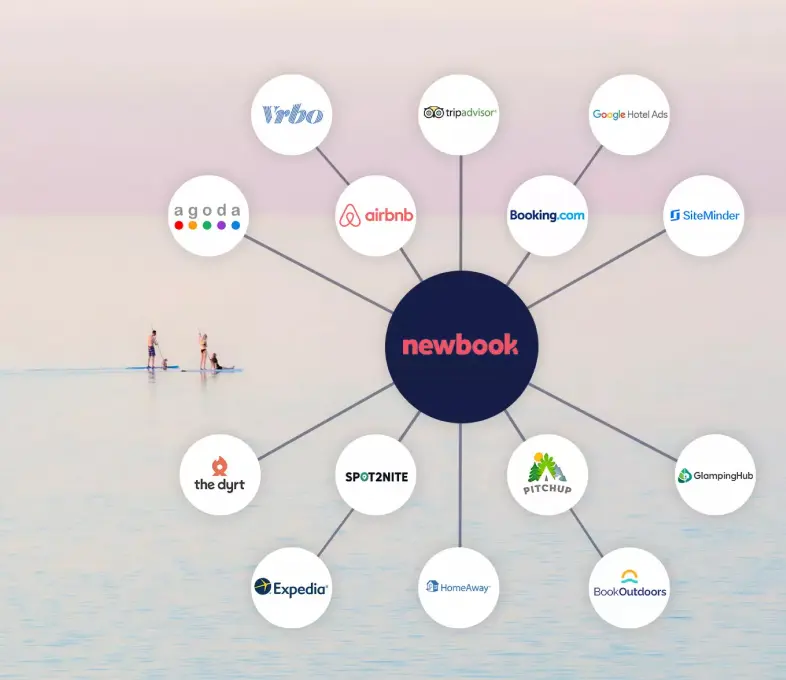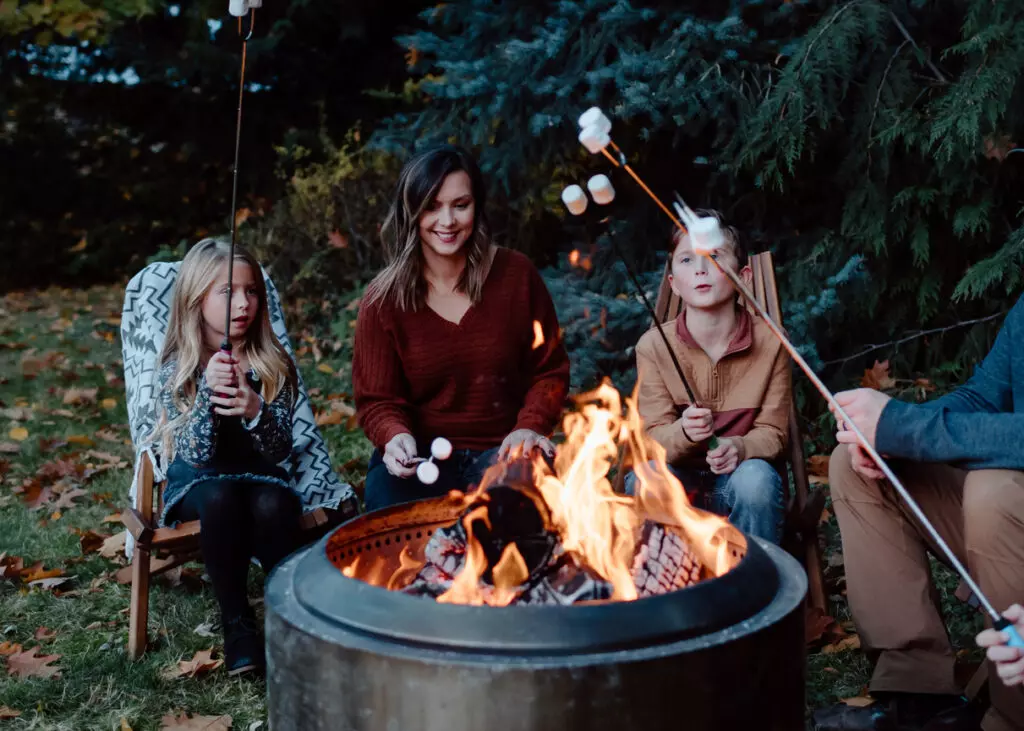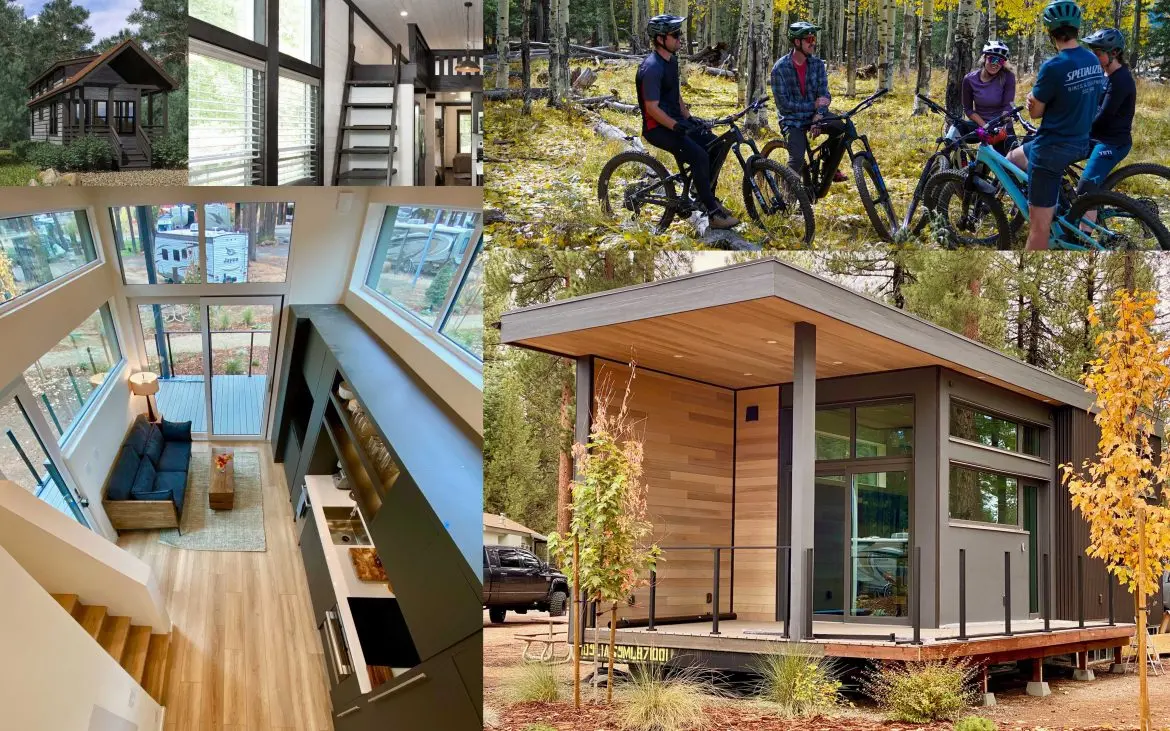You’ve got a lovely little campground tucked away in your corner of the world. Your regulars know where to find you, your signage is… adequate, and you’ve had that same brochure design since 2008. Why fix what’s not broken, right?
Wrong.
In this digital world we live (or camp) in, you need several ways for potential guests to find your campsite online.
Campsite finder platforms should be one of them.
If not, you might as well be invisible to the camping masses waving their credit cards in the air, looking for somewhere to pitch a tent this weekend.
In this guide, you’ll learn how to get your campground listed on the right platforms, how to tailor your listings to RV travelers and weekend warriors alike, and what tools can help you track results, boost online bookings, and make the whole process a lot less manual.
What Is a Campsite Finder and Why Should Owners Care?
A campsite finder is a tool (usually an app or website) that helps campers find and book campgrounds.
These platforms pull together listings from across the country, filter them based on location and amenities, and let campers compare options side by side. For you, that means visibility in front of guests who are ready to book right now.
For campers, it means they have an easy and convenient way to discover new destinations, compare options, and make booking decisions.
Still not sold? Think about it. When was the last time someone called your office asking for a brochure? Digital discovery has replaced traditional marketing methods, and campsite finder platforms are the new frontline for capturing attention and bookings.
Campsite Finder App vs. Campsite Finder Website: What’s the Difference?
There are two main ways these platforms show up. You have browser-based websites, and then, you have mobile apps. Yes, both work. But they serve different functions.
Apps are built for travelers in motion. They’re built for mobile, often load faster than the website, pull location data instantly, offer push notifications, and sometimes allow offline access. The campers using a mobile app are probably making decisions about where to stay while they are already on the road..
Browser-based versions are more for when a potential guest is using a laptop or desktop computer to access the website directly.. A campsite finder website is useful for planners who research thoroughly before booking. They can compare options and plan trips weeks or months ahead.
But if they’re already on the road, in an area with a spotty signal, or using voice search, they’re using apps.
Bottom line? The current user behavior trends clearly show the importance of both platforms. Over 60% of last-minute bookings happen on mobile, and voice search is becoming increasingly common.
For example, “Find me a campsite near Yellowstone” is a typical voice command that triggers location-based searches.
Geo-targeting has also revolutionized how campers find sites with a campsite finder app. As they drive, their phones can suggest nearby campgrounds with availability.
Why Every Park Owner Should Be On a Campsite Finder Online Platform
Let us paint you a picture. Sarah is stuck in her cubicle daydreaming about escaping to the great outdoors, so she whips out her phone and starts hunting for available campsites.
Is your campground showing up in her results? Or are you leaving money on the table while your competitors snap up these spontaneous weekenders?
To get in front of campers like Sarah, you need…
Visibility
Being on campsite finder apps means you’re in front of more people. More eyeballs leads to more bookings.
Credibility
Getting listed on trusted apps gives you built-in credibility. Campers trust platforms like The Dyrt or Hipcamp, and if you’re listed there, that trust extends to you.
Distribution
You can only do so much with your own website. Even with great SEO, you’ll never reach the kind of volume a campsite finder website pulls. Being listed helps you reach travelers who never would’ve landed on your page otherwise.
Managing Campsite Finder Listings
So how can you manage multiple listings on different campsite finder websites and apps? The answer is a channel manager. With Newbook, you’ll be able to manage multiple listings for multiple websites from a centralized interface. Plus, any changes you make to your pricing, descriptions, or images can be set as global changes, so you don’t have to manually update each listing. Plus, you’ll be able to list with as many campsite finder apps and websites as you want, with no extra fees.
More bookings, more often with our built in channel manager
Newbook is your all in one property management software. Talk to us today to learn how you can inprove operations and increase bookings for your business.


Types of Campsite Finder Platforms
Campsite finder platforms fall into a few categories:
- Aggregators pull listings from a wide range of sources and focus on reviews, filters, and user-generated content.
- Direct booking platforms let campers book directly through the app, giving you a streamlined reservation pipeline.
- Directory-style tools may not offer booking, but still drive discovery and link back to your main site or OTA.
Best Campsite Finder Apps for Campground Owners to Leverage
| Platform | Key Features for RVers | Audience Type | Monetization Model |
| The Dyrt | Offline search, trip planning, amenity filters | Long-haul RVers | Subscription + paid listings |
| Spot2Nite | Real-time availability, PMS integration | Convenience-focused travelers | Commission per booking |
| Hipcamp | Unique stays, nature-focused experiences | Younger, experience-driven campers | Service fees (guest + host) |
The Dyrt
With over 4 million users, this platform has become a camping community powerhouse. Its highly engaged user base contributes detailed reviews, photos, and tips. The typical Dyrt user skews younger (25-40) and is social media savvy. They value authenticity and community input when making decisions.
The Dyrt’s monetization model includes premium subscriptions for campers and enhanced listing options for campgrounds. Their strength lies in their review ecosystem. Campers trust the detailed, unfiltered perspectives shared by fellow outdoor enthusiasts.
If your campground delivers consistent quality experiences, The Dyrt’s review-centric approach can significantly boost your credibility.
Spot2Nite
Spot2Nite specializes in RV travel and real-time booking. It integrates with property management software (PMS) like Newbook, which allows for live availability updates and automated guest communication.
The app appeals to RV travelers who want fast, no-fuss booking. Spot2Nite earns revenue through booking fees and partners with campgrounds on a commission-based model, which is low-risk for owners to join.
Hipcamp
Hipcamp is known for its emphasis on unique and nature-based experiences. Its user base trends younger, often including vanlifers, glampers, and outdoor adventurers looking for quiet, rustic, or off-grid stays.
It functions as a direct booking platform and makes money by taking a commission from each reservation. This platform is a strong match if your campground includes private land, scenic views, or extra amenities like firewood or farm-fresh eggs.
Free Campsite Finder App vs Paid Listings
Free listings are the entry point. You’ll get basic visibility, a text description, and maybe one or two photos. That’s fine to start, but you’ll quickly hit limits.
Premium upgrades usually include:
- Featured spots in search results
- Direct booking buttons
- Multiple high-res images
- Review response tools
- Better analytics and tracking
Paid listings are worth it if:
- You want to move up in rankings
- You’re in a competitive market
- You want more control over your brand presentation
Start with a free plan, test engagement, then upgrade on platforms where you’re seeing results.
Tools for Targeting RV Travelers

RV travelers have very specific needs. RVers plan ahead, rely heavily on apps, and filter obsessively.
To show up in their search results (and stay in their good graces), you’ll need to understand how RV-specific platforms work and how to make your park stand out.
RV Campsite Finder vs Tent Campers: What’s the Difference?
Tent campers are usually looking for fresh air, a fire pit, and maybe a decent view. On the other hand, RVers are hauling around rolling homes and expect the works…
- Hookups
- Pull-through access
- Dump stations
- Strong Wi-Fi
…and maybe even a dog park for good measure.
That’s why RV campsite finder apps have with entirely different priorities in mind. These apps cater to travelers who can’t risk pulling into a site that’s too short or too sloped.
They use filters for amp levels, slide-out clearance, and road access. So if your listing doesn’t mention things like site length or your 50-amp service, you’re probably getting filtered out before they even see you.
Top RV Campsite Finder Apps That Drive Bookings
Features that stand out for RVers include detailed amenity filters, real-time availability (no one wants to call and wait), and GPS integration so they can navigate directly to your park without guesswork or Google Maps drama. Platforms that let them search by rig length, site type, and Wi-Fi strength are even better.
To drive bookings, your listing should:
- Tag your RV amenities clearly (don’t assume people know what “standard site” means).
- Upload high-quality, up-to-date photos—especially of hookups, pads, and roads leading into your park.
- Include RV-specific site details like length, amperage, surface type, and whether slide-outs will fit comfortably.
- Keep availability updated if the app allows for real-time booking. Nothing tanks trust faster than listing a spot that’s already full.
If you want to show up in filtered searches and win over travelers before they’ve even unhitched, make your listings as RV-specific, clear, and visually appealing as possible.
How to Optimize Your Listing on a Campsite Finder USA Platform
Getting listed is step one. But getting booked is where the magic (and strategy) happens.
To ensure your campground shows up in front of the right eyeballs and makes them hit “Book Now”,” you need to work the platform to your advantage.
Campsite Finder USA: Reaching the Right Campers at the Right Time
Platforms like Campsite Finder USA help you connect with campers who are already planning their next getaway. Your job? Make your listing show up when and where it counts.
Use seasonal tags like “fall foliage” or “summer lake getaway” to tap into travel trends and show up in seasonal searches. Mention local attractions. Yes, even the quirky roadside ones.
If you’re near a national park, a famous hiking trail, or the best fried pie in the state, call it out. Campers love pairing their stays with things to do.
And don’t underestimate the power of geo-targeted descriptions. Instead of saying you’re “centrally located,” say “just 20 minutes from downtown Asheville” or “right off Highway 101 near the Oregon Coast.” Be specific. It helps travelers find you, and tells the algorithm you’re worth showing off.
Photos, Reviews, and Real-Time Data: What Makes the Best Campsite Finder Listings Stand Out
Want more clicks that turn into bookings? Then your listing needs to stop campers mid-scroll.
| What to Optimize | What to Include | Why It Works |
| Photos | Clear shots of each site type, hookups, bathrooms, entrances | Helps guests visualize their stay and builds trust |
| Descriptions | Site size, RV length limits, surface type, nearby attractions | Makes it easier to show up in filtered search results |
| Tags and Keywords | Seasonal themes, pet-friendly, kid-friendly, trail access | Improves discoverability across platforms |
| Availability Info | Real-time booking, synced calendar, accurate pricing | Reduces friction and encourages fast conversions |
| Guest Reviews | Follow-up review requests, responses to all reviews | Builds credibility and shows you care |
Photos that your guests care about
No one books a site based on a blurry tree line and a random picnic table. You need clear, high-resolution photos that tell the full story. Start with 10 solid images, minimum. Prioritize shots of:
- Each type of site (RV, tent, cabins, if you’ve got variety, show it).
- Hookup points and parking surfaces. People want to see where their rig or gear will go.
- Amenities: bathrooms, laundry, dump station, pool, playground, whatever sets you apart.
- Park entrance and internal roads so guests know what they’re navigating.
Reviews that build trust
98% of consumers read online reviews. And many won’t book without seeing at least a few recent ones. After each stay, follow up with a quick message or automated nudge asking for a review. Keep it light and casual
Example: “Hope you enjoyed your stay. Mind sharing a quick review to help other campers?”
Don’t ignore reviews either. Respond to every single one. A short thank-you works great for positive feedback. For the not-so-glowing reviews, stay professional, own what needs owning, and show potential guests you’re listening and improving.
Real-time information that saves time
Platforms with real-time availability and instant booking features tend to rank listings higher and convert better.
If your site is open, make sure it shows as open. Campers don’t want to call, email, or guess. Sync your availability if the platform allows it, and keep details like pricing, amenities, and check-in instructions up to date.
Measuring the ROI

You’ve listed your park. The photos are crisp, the reviews are rolling in, and your Wi-Fi actually works. Great. But how do you know your campsite finder listings are pulling their weight?
It’s time to track the return on investment, because “it feels like we’re busier” isn’t exactly a solid metric.
Tracking Traffic and Bookings from Campsite Finder Apps/Websites
Most campsite finder platforms give you a backend dashboard where you can see how many people viewed your listing, clicked the “Book Now” button, or followed through to your site.
If the platform gives you direct links to your booking page, make sure those URLs are tagged with UTM parameters.
These tags let you track traffic in Google Analytics to see where your bookings are coming from. No more wondering if that recent bump in reservations was from a platform feature, a new photo, or that Facebook ad you ran three weeks ago.
Even if a platform doesn’t provide detailed analytics, watch your reservation volume and cross-reference it with the dates you updated listings, ran promotions, or added new platforms.
And don’t stop at the first booking. Track your conversion rate. A basic conversion rate formula looks like this:
(Number of bookings ÷ Number of listing views) × 100 = Conversion Rate (%)
Let’s say you had 1,000 views and 25 bookings last month. That’s a 2.5% conversion rate. Not bad. But if you had 2,000 views and only 10 bookings, your listing might need some attention.
What can affect conversion rate?
- Poor or outdated photos
- Missing site details (no one wants to guess whether their 40-foot RV will fit)
- No real-time availability or pricing
- Vague or generic descriptions that don’t speak to what campers care about
To improve conversion rate, test small changes:
- Update your headline to make it more specific (“Shaded Pull-Through RV Sites Near Zion” beats “Campground in Utah”).
- Add 2–3 new photos showing key features like hookups, bathrooms, and actual site size.
- Clarify pricing and site details so there’s no ambiguity during booking.
Track the impact of each tweak over time. Even a 1% improvement in conversion rate can translate into dozens of extra bookings per season.
Understanding the Lifetime Value of a Guest
One weekend stay is nice, but repeat guests is the goal.
Let’s say a camper finds you through Spot2Nite, stays for a weekend, and spends $100. If they had a great time, you send a follow-up email, and they rebook next season. Now you’ve doubled their value without paying for another listing click.
And let’s say they bring friends or leave a glowing review that brings in more guests. That one $100 booking just multiplied.
This is why it’s important to look at guest retention and total spend over time, and not just the first transaction. Tracking things like repeat stays, word-of-mouth referrals, and review mentions can help you get a clearer picture of your return on investment (ROI) and revenue growth.
Pro tip: Look at the average spend of guests you acquired from each platform. Some tools may bring in more budget campers, while others attract high-end RVers looking for full-service sites and premium amenities.
Using PMS Tools to Connect, Automate, and Upsell
Are you still managing bookings with sticky notes, spreadsheets, or an inbox full of “Is this site still available?” messages?
Consider a solid property management system for more organized reservations. This helps you connect the dots between your listings, your operations, and your bottom line.
- Sync your listings across platforms: Campsite finder apps can integrate with PMS tools like Newbook. This means your site availability updates in real time. So, when someone books on one platform, it blocks that spot everywhere else automatically. You don’t have to worry about double bookings or those awkward “Sorry, we’re actually full” emails.
- Automate the repetitive tasks: The beauty of a PMS? It works behind the scenes while you’re running the park (or, you know, finally taking a lunch break). You can automate site assignments, payment reminders, and even gate codes if your system supports it. You can also set up automated emails to:
- Confirm bookings instantly
- Send pre-arrival details and park rules
- Request reviews after checkout
- Remind past guests to come back next season (with a friendly discount, if you’re feeling generous)
- Upsell like a pro: Once a guest books, your PMS can prompt them to add on extras, like late checkout, firewood bundles, kayak rentals, you name it. These little upsells add up fast and are easy to implement through customizable add-on menus or post-booking emails. The best part is, you’re not bugging people with salesy pitches. You’re offering helpful upgrades at the perfect time, while they’re still in trip-planning mode and more likely to say “yes.”
eBook: 5 Powerful Ways to Use Automated SMS
“We made an additional $7000 in one month by using SMS Late Check-Outs.” Find out how you can too!


Ready to Boost Your Campground’s Visibility and Bookings?
Campers are actively searching for their next great stay, and campsite finder platforms are one of the fastest ways to get your park in front of them. A clear, well-optimized listing with real-time availability, strong visuals, and thoughtful details helps turn that visibility into confirmed bookings.
To keep everything running smoothly behind the scenes, property management software offers the tools to connect your listings, streamline operations, and create standout guest experiences from booking to checkout.
Ready to elevate your campground’s presence? Reach out to Newbook and discover how our platform can help you streamline your operations and grow your park with ease.
So you manage a campground? We make it easy
Newbook is your all in one campground management software. Talk to us today to learn how you can improve operations and increase bookings for your campground.



